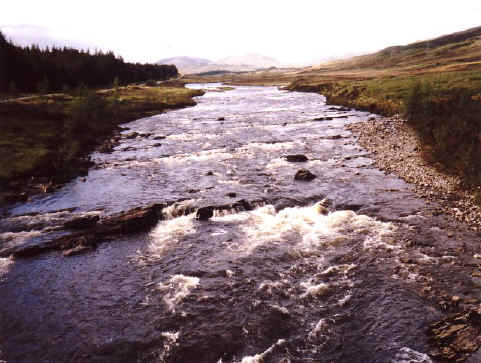 River
Orchy from the bridge
River
Orchy from the bridge|
A very wet walk through Glen Orchy, Glen Kinglass and Glen Etive |
From Tyndrum the
road and railway, the river Orchy, the power lines and our track all head for
the gap between the towering bulk of Beinn Berg to the West and Beinn Odhar to
the East. The climb to the pass is fairly gentle and we soon breasting the rise
and looking North into the broad flat bottomed glen that opens out allowing the
road to skirt off to the left. and the railway to part company and cling to the
eight hundred foot contour around the flanks of the slopes on the right.
Beinn Dorain at
three thousand five hundred feet stood boldly before us, it's western flank
sweeping down in an unbroken scarp to the Bridge of Orchy about seven miles
away. Here the road and railway are squeezed together again before breaking
apart to make very different crossings of the vast wastes of Rannoch moor.
The easy walking
along this well use track which is part of the West Highland way, helped us re
acquaint ourselves with the heavy packs which we had not carried since our
journey to Tongue in Sutherland a couple of years ago. We had walked plenty of
miles since, but we had not carried three days provisions and the tents, stove,
etc.
Blue skies,
soaring white clouds and a fine fresh breeze made it really good weather for
walking, there were a few black clouds around and we had seen rain earlier in
the day as we drove to Tyndrum but now things looked quite promising. A mile or
so beyond the bridge at Auch we sat among the rocks and savoured the views.
 River
Orchy from the bridge
River
Orchy from the bridge
Below, the
river meandered its way across the flood plain gathering the bums that bounced
down from the high glens. In a mile or so it would meet with the icy waters that
flow from Loch Tulla and race on down through Glen Orchy before meeting the
tidal waters of Loch Awe.
The drone
of the traffic on the A82 trunk road reached us from across the river Tourist
coaches, cars and caravans bound for Glencoe and Fort William carrying folk to
their highland holiday. Our highland holiday will be a little different. After
leaving Forest Lodge tomorrow it's unlikely we'll see a soul until we arrive at
Taynuilt.
The power
lines now marched along the flanks of Beinn Dorain a few hundred yards or so
above us. New timber poles ready fitted with porcelain insulators had been laid
carelessly in the heather close by each standing pole ready to be installed in
place of the old ones, some of which now leaned at rakish angles, telling
perhaps that they had endured many a hard winter while holding in place the
lines that supply the vital energy to wild and lonely places.
The new
installation would be quite a task for someone.
As we sat
enjoying the highland air the white clouds gradually change their character,
white clouds gave way to grey clouds, rain was in the air, we could see it
sweeping across the hills before us.
Today
however was different, the rain held off, we had dry weather to set up camp on
the river bank a few hundred yards upstream from the pub by the bridge.
Nine years
ago we had camped at the same spot and had taken advantage of the meals served
at the pub. A sign outside still proclaimed 'Bar Meals' and as we were by now
feeling quite hungry (and thirsty) we crossed back over river. On the way we
spotted a pair of dippers flitting among the rocks at the waters edge, one flew
straight at the bridge parapet and disappeared as if by magic, presumably she
had a nest in a crack somewhere. We settled ourselves at a table in the bar. It
was busy, most people were eating. The food smelt good.
On our
previous visit there were several hardy souls who like ourselves were walking
the hundred mile or so from Glasgow to Fort William with their homes on their
backs. Then the river bank had gradually acquired quite a population, now it
seems there is a camping barn at the Bridge of Orchy hotel, most of the people
in the pub were either staying in the barn or creeping between crisp white
sheets in the cosy bedrooms upstairs at night.
We had our
fill of the excellent chicken and ham pie, washed it down with rather more ale
than originally planned, then wandered out into the night and crawled into our
tents. As we zipped up, the gentle patter of rain on nylon started as the 'warm
wet Westerly brought the first of the showers that were the forerunner of
something very much worse.
The rattle
of the rain did not keep me awake, chicken pie and brown ale (in sufficient
quantities) make for a good nights sleep.
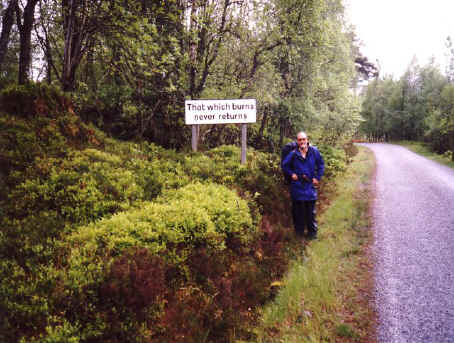
Morning
came, the rain was intermittent but a glance outside made it plain it was not
going to be very pleasant, the cloud base was down to about fifteen hundred feet
and along the glen ragged streamers trailed from the grey forbidding masses that
blew in from the West.
As we
packed the tents the heavens opened and we had to roll very wet tents into their
packs, there was no chance to shake the water off as it was coming down faster
than we could clear it. A wet tent is a heavy tent. It can't be helped we've
done it all before.
The river
Orchy alive with the runoff from the surrounding hills charged on down the glen
eager to find its way to the sea perhaps some twenty miles away. It had
chattered and burbled all night but 1 had slept well and was now keen to get
along the way towards Forest lodge and the start of the wild walking.
We passed
a group of campers near the Inveroran Inn where a chap told us the forecast was
better for the afternoon. We hoped he was right, our plan was to take a
leisurely stroll up to loch Dochard and have a lazy lunch there, perhaps a doze
in the sunshine and look for Golden Eagles with the binoculars. The area has a
high Deer population, if we rested quietly for an hour or so there was a good
chance that we would see them close by.

In the
distance we caught sight of the bridge that we had to cross before reaching loch
Dochard. By now the rain was heavy making the ground underfoot very boggy in
places. Although we could see the route it was impossible to follow it very
closely we, were making detours most of the time and hopping from rock to rock,
tussock to tussock in a vain attempt to keep our feet dry.
The bridge, when we arrived was a surprise, it was, or had been quite a structure. High wooden pillars at either side of the river supported steel hawsers which in turn supported a plank walkway flanked on either side by a timber handrail. On closer inspection we found that some of the steel hawsers had broken and lay rusting away, the timber handrails had long ago collapsed leaving rickety posts standing alone. The slippery looking planks of the walkway itself were in an alarming condition with some boards missing, others looking as if they were unlikely to bear much weight and most alarming of all, some,, when stood on at one end would shoot into the air at the other end returning with a clatter.
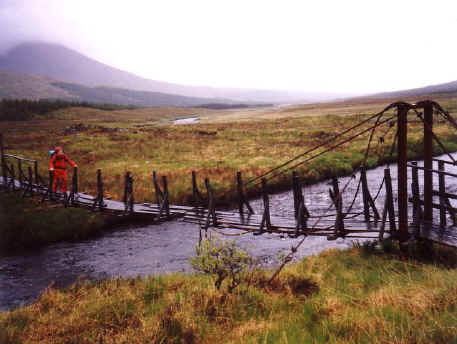
In the
gloom under the glowering grey rain clouds it all looked very sinister,, but we
were soon across without incident and onto a much improved track. This track we
could see stretched away gently upwards to where a lip had formed at the last
ice age as a glacier had started it's retreat. Behind this, loch Dochard had
formed.
It was
raining hard, and as we came over the brow and looked down to Dochard the wind
hit us, we were flow exposed to the West from where the wind and rain was
sweeping up Glen Kinglass.
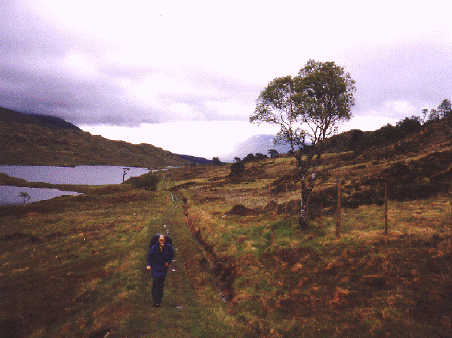
Ahead a
building stood close by the track, in the poor light the window looked like a
black hole. I became focused on the idea of climbing through and finding
shelter, it would be somewhere to rest and have our lunch. As I leaned in at the
open window Paul walked round to the front and pushed the door, it flew open.
The
building was a stable for three ponies. In the stalking season ponies would be
tethered here waiting for the signal to go on the hill to retrieve an
unfortunate Stag,, the victim of the days stalking. The rest of the year these
shelters stand empty, this one was in a fine position overlooking the loch.
Across each stall a beam about six inches wide and three feet from the ground
provided a dry bench for a rest. We took off our streaming waterproofs and hung
them to dry off while we had some food. We stayed in the stable for an hour or
so, the whole of the time the rain sounded terrible hammering on the corrugated
sheet roof. It was very reminiscent of a few years earlier when we had sheltered
in similar circumstances in a steading in glen Fhiodhaig, that day a rat came
in to shelter with us.
A glance outside told us that there was no real prospect of an improvement in the weather, so when rested we set off up to the watershed from where we would walk down into Glen Kinglass. As we left the stable the rain did ease for a few minutes and we did have chance to take in the terrific scenery and the bare rock landscape to the North.
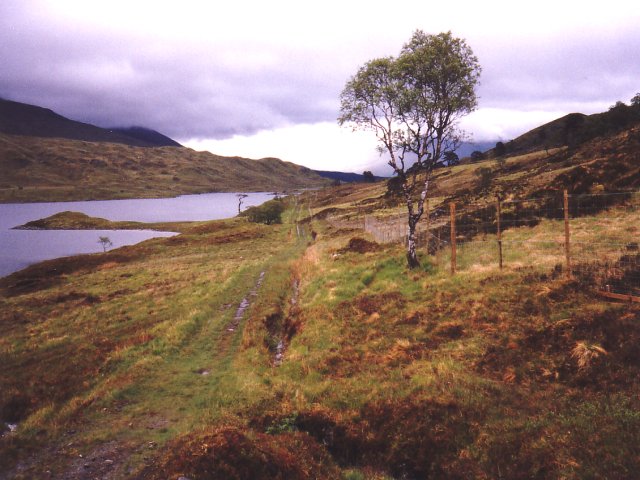
The path
rose gently and to our right at the head of the loch a vast amphitheatre studded
with lochans is surrounded by great buttresses of mostly bare rock, between each
buttress deep gullies were etched with foaming white torrents of water, some
draining into Dochard others slanting away into glen Kinglass. This was pure
theatre. For a while it was easy to forget the rain and simply enjoy the
grandeur of the setting. Great plumes of spray rose as water crashed over
boulders in it's path.
As we crossed the watershed the track was lost among great slabs of almost horizontal bare rock, neither moss nor any lichen had managed to grow on these exposed slabs. Today they streamed water as we sloshed across them slanting down toward a bridge that had come into view below us. Although this was the headwater of river Kinglass it was deep and swift,, impassable without the bridge suspended from steel cables that spanned the water. This bridge had been maintained to better state of repair than the earlier affair but the steps leading to the single plank walkway had collapsed and had been replaced by a slippery looking plank at an angle of about forty degrees. The bridge swayed about alarmingly as we crossed one at a time, however we were soon onto the track that lead gently down along the length of Glen Kinglass.
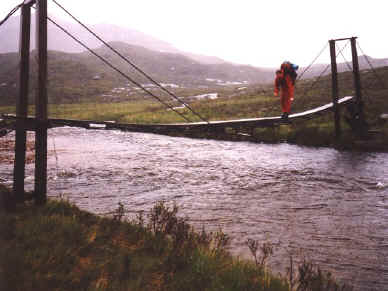
Our path gathered the water pouring down from the hillsides and before long was itself a swiftly flowing stream too deep to walk along. Once more we had to revert to picking our way across the rough terrain, avoiding the track and the boggy areas that were everywhere. The river to our left and the waterfalls coming down from our right were tremendous, 1 have never seen anything quite like it, if the estate owners had not installed the bridges that carried us over the mountain runoff the route would have been impassable.
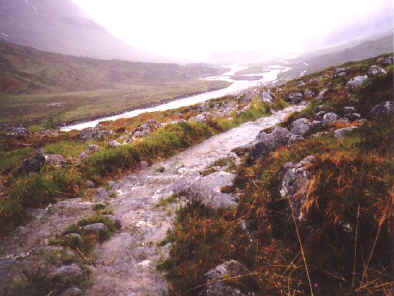
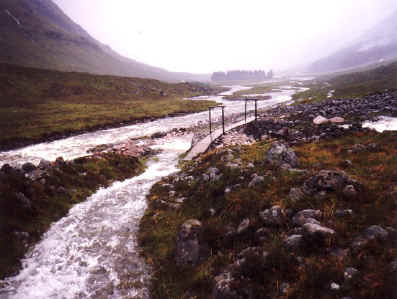
Near the
Lodge the small wood looked as though it could give us some shelter, but beyond
the lodge the track improved greatly and the remaining miles to Narrachan seemed
a more realistic option.
The track
had been upgraded for use by the estate vehicles going up to Kinglass lodge, it
made it fairly easy walking for us. Ahead we could see deer down by the track,
as soon as they were aware of us they took fright and disappeared behind a low
hill by the river. As the glen floor levelled off the river broke its banks and
spread over the floodplain as a sheet of water a few hundred yards wide studded
with tree clad islands stretching away into the gloom ahead. Here I caught a
glimpse of splashing in the distance, the deer were now in shallow water
appearing, as they made their way down the glen before us, to very gracefully
run across the surface of a lake.
We had
reckoned to be down to Narrachan in about two hours after passing the lodge and
as the time elapsed we began to look for the shelter. With the rain still very
heavy we had our hoods up restricting our view, it's easy to miss something when
not sure what to look for, but eventually between the track and the river we
spotted a tiny timber hut with a corrugated sheet roof.
A large
stone held the door closed, we rolled it aside and went into the gloomy but dry
interior. After a few minutes rest on the wooden benches that ran along two
sides we went outside to survey a site for the tents, the hut was too small to
give us a comfortable place to sleep, but was ideal for us to keep our gear dry
while we pitched camp.
It had
been a terrific days walk, very dramatic, very awesome, Glen Kinglass had not
been a disappointment but the weather had.
Morning
came and the rain had stopped. 1 had been aware of showers pattering on the tent
but the intervals between them seemed quite long. Once outside the tent it was
confirmed that today the weather was to be better, high white clouds floated
across a blue sky to the East, while to the South and West we could see there
was still rain about. It had to be better than yesterday.
The river
had dropped by about fifteen feet and now tumbled along quite happily looking
nothing like the raging torrent of yesterday.
As we
packed the rucksack we had a visitor. 'Morning gentlemen' said the voice as the
hut door opened. It was the estate Stalker no doubt curious as to why a shirt
and a pair of trousers were hanging out to dry at the back of the hut.
He was a friendly chap, he explained to our surprise that this was not the shelter for walkers that we had looked for, but his fishing hut. He told us of a more substantial shelter a few hundred yards back that he maintains, but neither was that for walkers as we had been lead to believe in a magazine article. No matter, either place on a day as yesterday has a terrific value, for us it made things much easier as indeed had the stable above loch Dochard at a time when we needed shelter. He agreed we were right to camp well above the river, at times the water came up the sides of the hut. As we suspected the first rickety bridge on yesterdays walk was no longer being maintained by the estate, without it this walk through Kinglass will be impassable when the Abhain Shira is too full to ford.

We walked
the remaining few miles down the glen in good weather, this was a nice change,
but we were soon back into waterproofs as heavy showers swept across the water
reminding us that you can never take the weather for granted in the highlands.
At the foot of Kinglass the path skirts a beautiful small oak wood completely carpeted with bluebells, with the sun slanting down through the trees it was almost magical. Here the track turned abruptly across the river before climbing over a low headland and giving us stunning views both to the Northeast as Glen Etive lead the eye towards the distant big hills that flank the Rannock Moor and the pass of Glencoe, and to the Southwest to Taynuilt where Etive sweeps Westward on down to the Firth of Lorne beyond Connel Bridge.

The track
wanders up and down over a few headlands and passes several isolated dwellings
at Inverliver and Glennoe before entering the woodland above Bonawe. It was at
Glennoe that we surprised a herd of deer grazing, on seeing us they leapt with
the greatest of ease over the fence that now enclosed the track, and raced away
before stopping to watch us from a distance.
Eventually
we arrived at the smokeries at Bonawe, from here the track leads across a field
to the slender bridge that spans the River Croe and on into the village of
Taynuilt and the railway back to Tyndrum.
It had
been a good walk but not done as planned. Instead of the lazy stroll with
frequent stops and the odd doze in the sun, the weather had made us keep on the
move and thus walking much further on the second day than planned. This had the
effect of making the trip a day shorter than we intended, but there is no fun in
sitting about in the rain.
June 1996.